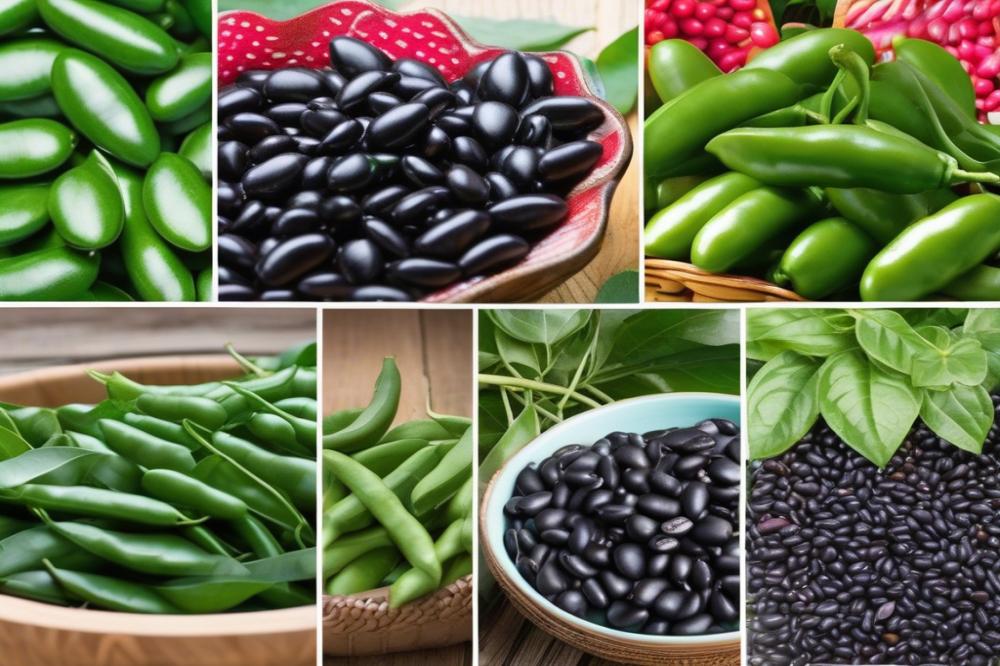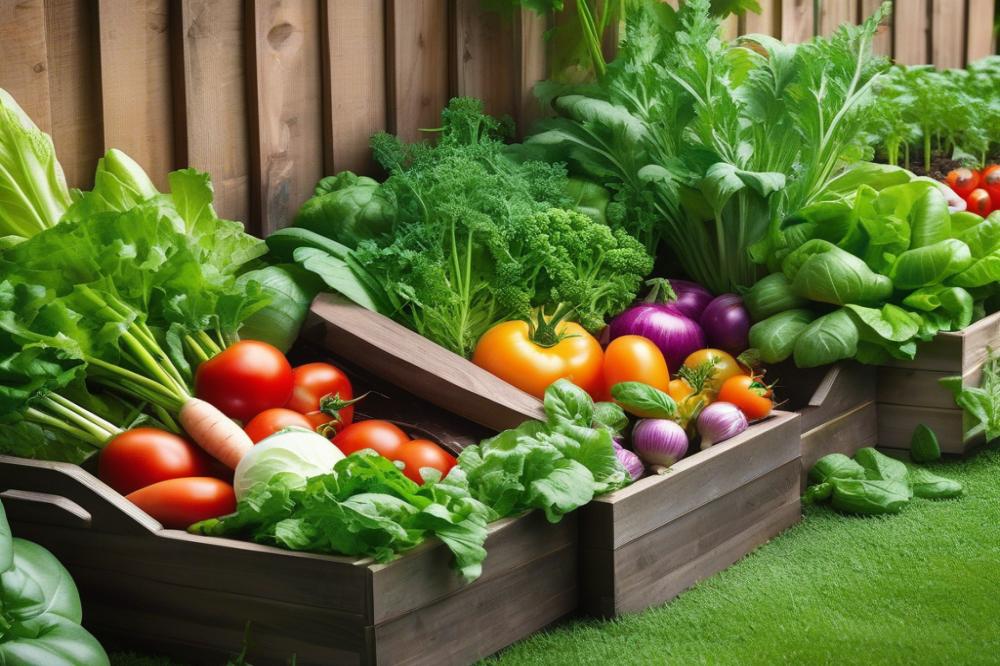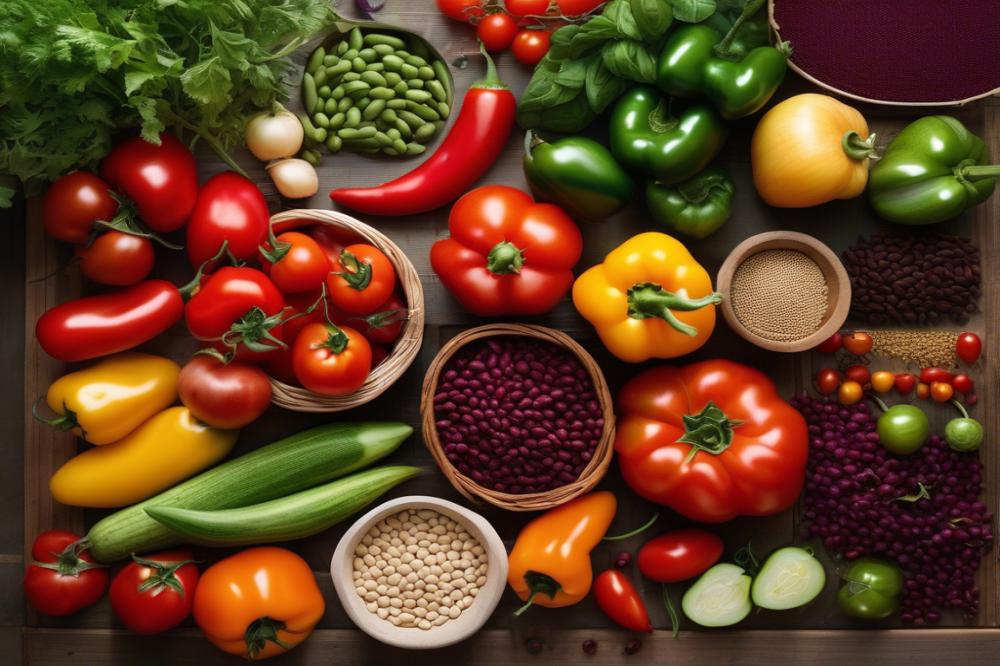Introduction
black beans are a staple in many diets around the world. They are not just tasty; these legumes are packed with protein, fiber, and essential nutrients. Their dietary benefits make them a popular choice for many, especially in vegetarian and vegan meals. Additionally, they play a significant role in sustainable agriculture, promoting healthy soil and crop diversity.
Growing these beans comes with various advantages. For one, they can thrive in diverse climates and soil types. This adaptability means they can fit easily into most gardening plans. Furthermore, black beans enrich the soil through nitrogen fixation. Incorporating them into crop rotation can significantly enhance farm productivity.
A few basic methods of planting and harvesting should be explored. Different varieties of beans may require particular attention in terms of care and climate. Understanding which techniques to implement can directly impact yield and plant health. soil preparation is vital for success. A well-tended garden bed encourages strong growth and reduces the risk of diseases.
Consider the importance of pest management and irrigation in this process. Simple gardening tips can lead to better outcomes and a bountiful harvest. Choosing organic farming practices not only benefits the environment but can also yield healthier crops. The right timing for planting, along with careful monitoring, is essential for harvesting techniques that preserve the quality of your beans.
In summary, understanding the intricacies of growing these legumes involves a combination of knowledge and practical strategies. With the right approach, growing black beans can be rewarding and beneficial for both the gardener and the environment. Get ready to dig deeper into the methods that can lead to a successful harvest!
Soil Preparation


The foundation of successful gardening lies in the conditions of the earth itself. Black beans flourish in well-drained, nutrient-rich soil. Without the right environment, even the best seeds cannot thrive. Understanding how to prepare the soil is crucial for optimal growth.
Soil testing is a vital step in this process. Testing provides insights into nutrient levels and pH balance. Many local agricultural extension services offer testing kits. Analyzing the results helps gardeners learn what amendments might be necessary. Common amendments include compost, which enriches the soil, and lime, which can help adjust acidity.
For black beans, the ideal pH level is between 6.0 and 7.5. This range supports nutrient availability, promoting healthy growth. Nutrient requirements vary, but key components include nitrogen, phosphorus, and potassium. These nutrients play important roles in creating a robust plant capable of resisting pests and diseases.
Employing organic farming methods can improve soil health over time. Crop rotation is another effective technique for maintaining soil vitality. Rotating crops helps reduce disease issues and balances nutrient depletion. Additionally, implementing smart irrigation practices can prevent soil erosion, sustaining its quality.
Gardening tips for preparing soil also include the consideration of climate. Different climates may affect moisture levels and nutrient availability. Amending soil based on these factors enhances the likelihood of a successful harvest. Pest management strategies should also be in mind, as healthy soil can lead to stronger plants that can better resist pests.
Ultimately, the preparation of soil sets the stage for any garden. Thoughtful planning and execution yield rewards in growth and harvest. Focusing on sustainable practices fosters not only successful gardening but also a positive impact on the environment.
Bean Varieties


When planting beans, it’s important to know the different varieties available. Each kind has unique characteristics that can affect both growth and flavor. Black beans, for example, come in several types, including the traditional black turtle bean, which is often preferred for its creamy texture and rich flavor. Other options include the Cuban black bean and the Peruvian black bean, each offering distinct taste profiles.
Choosing the right variety depends significantly on climate conditions and desired yield. Some varieties thrive in warm, humid areas while others are better suited for cooler climates. Understanding your region’s climate helps gardeners select beans that can produce the best harvest. soil preparation also plays a role in this choice. The right nutrients and conditions complement specific varieties and can lead to robust growth.
Comparison of Traits
Flavor and texture can vary widely among bean types. Some beans are smoother, while others are firmer, providing different experiences in meals. Different growth habits are also noteworthy. Certain plants grow upright, making them easy to manage. Others may spread across the garden, requiring more space and careful consideration for crop rotation. Gardeners should also take pest management and irrigation needs into account when selecting a variety.
Many farmers prefer organic farming methods to cultivate beans. These sustainable practices not only lessen the impact on the environment but also enhance the natural flavor of the crops. Additionally, proper irrigation can significantly influence the success of the chosen bean variety. Careful attention to these elements helps maximize yield and ensures a healthy harvest.
Planting Techniques


Best Planting Times for Black Beans
Planting occurs best in warm weather. Aim for late spring when soil temperatures consistently reach around 70°F. This ensures that seeds germinate quickly. In many areas, the window for planting extends into early summer. However, timing may vary based on local climate conditions. Gardeners should consider their region’s first frost date. Planting too late can lead to poor yields.
Planting Depth and Spacing Considerations
Depth plays a vital role in successful planting. Seeds should be sown approximately 1 to 1.5 inches deep. Adequate spacing helps plants thrive. Aim for distances of about 2 to 4 inches between each seed. Rows should be spaced 18 to 36 inches apart. Proper spacing promotes airflow and reduces disease risk. A well-prepared garden bed enhances soil quality. Before planting, consider soil preparation to encourage healthy growth.
Use of Companion Planting for Improved Growth
Companion planting can significantly boost growth. Certain plants, like corn and squash, help black beans thrive. These companions can offer shade, support, or nutrients. Crop rotation is another important technique. Different plant families can break cycles of pests and diseases. Additionally, pest management is essential in maintaining healthy crops. Organic farming practices often benefit from companion planting strategies. Gardening tips suggest mixing it wisely for better yields.
Irrigation Practices


Watering techniques play a crucial role in growing healthy crops. Without proper irrigation, plants may suffer from drought stress or root rot. Finding the right balance is vital for plant health, especially throughout the season.
Efficient irrigation strategies can save time and resources. Drip systems deliver water directly to the roots, minimizing waste. This method is particularly effective for maintaining soil moisture without overflowing. Additionally, using rain barrels can conserve water and utilize natural rainfall. Mulching around plants helps retain moisture and keeps the soil temperature stable.
Adjusting watering techniques based on growth stages is important. Young seedlings require more frequent watering as they establish roots. During flowering and pod development, moderate irrigation is essential. Overwatering at this stage can lead to diseases. In contrast, during dry spells, plants may need more water. Regularly monitoring weather conditions helps guide your irrigation schedule.
Soil preparation prior to planting is the foundation of effective watering. A well-aerated soil allows moisture to penetrate deeply. Crop rotation can benefit soil health, improving its structure over time. Also, consider the unique qualities of different bean varieties, as they may have varied water needs.
Implementing sustainable practices in irrigation can enhance environmental health. Organic farming techniques, like incorporating compost, can improve soil moisture retention. Effective pest management reduces plant stress, thereby requiring less water. By understanding climate considerations, you can adjust your irrigation practices as needed.
Climate Considerations
Optimal Climate Conditions for Growing Black Beans
growing beans thrives in warm environments. These plants prefer temperatures between 70°F and 90°F. They require full sunlight to develop properly. Consistent warmth promotes healthy growth and enhances yield. A frost-free period is crucial for successful cultivation. Excessive moisture can lead to plant diseases or root rot. Therefore, farmers should seek out locations where the climate maintains steady temperatures and doesn’t experience sudden cold spells.
Adaptation to Different Climates
Black beans can adapt to various climates. They grow well in tropical, subtropical, and temperate zones. Plant varieties have been developed to tolerate different conditions. Some seeds can withstand drought, making them ideal for dry regions. Others flourish in colder climates. Specific soil preparation techniques can enhance their growth potential regardless of regional challenges.
Seasonal Growth Patterns and Timing
Timing is essential when planting seeds. Spring offers the ideal time for sowing. This season provides warmth as well as the right moisture levels for germination. It’s important to pay attention to local weather patterns. Irrigation plays a significant role during dry spells. Some growers may need to adjust their watering schedules based on seasonal changes. harvesting techniques can vary depending on when plants reach maturity. Typically, beans are ready for picking in late summer or early autumn. Crop rotation practices can also help maintain healthy soil and balance nutrient levels. Regular pest management should remain a priority throughout the growing season. This ensures the plants remain vigorous and productive.
Gardening tips are useful for maintaining an optimal environment. Organic farming methods can also contribute to sustainability. By implementing these practices, growers not only support ecosystems but also improve their chances for success. Every step helps in cultivating a bountiful harvest. Each decision impacts growth, health, and yield of the plants.
Pest Management
Common Pests That Affect Black Beans
Many pests threaten the health of black beans. Aphids are a frequent problem, sucking sap and weakening the plants. These tiny insects can multiply quickly, creating a significant threat. Another common pest is the Mexican bean beetle. This beetle feeds on the leaves, making them look ragged. Cutworms also pose a risk, attacking seedlings at the soil line. Recognizing these pests early can help protect your crop.
Organic Pest Control Methods
Gardening tips often emphasize using organic methods for pest control. One effective way involves introducing beneficial insects. Ladybugs and lacewings can help reduce aphid populations. Neem oil is another option. This natural pesticide disrupts insect life cycles and can deter many pests when applied correctly. Companion planting can also be useful; growing marigolds nearby helps repel harmful insects. Soap sprays are a simple and effective homemade solution, helping to wash away pests without harming the plants.
Preventive Measures to Protect Plants
Taking preventive steps is essential for a healthy harvest. Proper soil preparation can strengthen plants and make them more resistant to pests. Rotate crops each season to break the life cycles of pests. This practice also improves soil health and fertility. Climate considerations are vital; ensuring plants are not stressed by drought or excessive rain can lower pest attacks. Implement irrigation methods that promote deep root growth, making plants stronger. By creating a robust environment, you can enhance your sustainable practices and enjoy better yields.
Crop Rotation
Benefits of crop rotation for black beans
Crop rotation plays a key role in sustainable practices. It helps maintain soil health and improve yields over time. By changing the type of crop grown in a specific area, you can reduce the risk of pests and diseases. Specific crops can replenish nutrients in the soil, preventing depletion. Utilizing this method supports diverse ecosystems, promoting natural pest management.
Recommended crop rotation schedules
Farmers often suggest a three to four-year rotation plan. Start with legumes, which build nitrogen in the soil. Follow these with cereal crops, like corn or wheat, before returning to a legume. This sequence balances the soil’s nutrient profile. Planting cover crops between rotations can enhance soil structure. Timing is crucial; plant according to local climate considerations.
Improving soil health and reducing pests and diseases
Healthy soil is vital for any successful garden. Crop rotation not only enhances nutrients but also disrupts pest life cycles. For instance, root-feeding pests can be diminished when crops are swapped. Organic farming techniques, like mulching and composting, further support soil health. These practices combined lead to less reliance on chemical fertilizers and pesticides. Consider using diverse bean varieties to improve resilience. Adopting proper irrigation methods also protects against soil erosion. Gardening tips can help ensure the best practices are implemented effectively.
Harvesting Techniques
Signs that Black Beans are Ready for Harvest
Monitoring your plants closely gives crucial insights. When the pods change color from green to a yellow-brown shade, that often signals ripeness. A good test involves shaking the plant. If you hear dry beans rattling, it’s likely time to gather them. Additionally, check the leaves; they will start to yellow and dry out as the harvest approaches. This is a natural part of the growth cycle. Observing these signs helps you determine the right moment for harvesting.
Proper Harvesting Methods to Avoid Damage
Using the right harvesting techniques is essential for maintaining quality. Begin by gently pulling the pods off the plant by hand. Using tools like scissors or garden shears may help reduce strain on the stem, but be cautious. Avoid bending the plant too much, as this can damage it. Work early in the day when dew is still present. The plants are less brittle then, making it easier to harvest without breaking them. Always handle the beans carefully to prevent bruising or crushing.
Post-Harvest Processing and Storage
After collection, immediate processing is critical. Begin by drying the beans in a sunny spot or using a dehydrator. Proper drying reduces moisture and prevents mold growth. Once they are fully dried, store the beans in airtight containers. Keep them in a cool, dark place to maintain freshness. Using pest management strategies during storage plays a key role in preservation. Opt for organic farming methods when dealing with pests. Additionally, rotating crops annually helps maintain healthy soil. These sustainable practices keep your next harvest thriving. Remember, climate considerations affect storage and processing. Adjust your methods based on local weather patterns for the best results.
Gardening Tips
General Tips for Successful Black Bean Cultivation
Planting beans requires careful soil preparation. Choose a rich, well-drained soil with plenty of nutrients. Before planting, mix in compost or well-rotted manure to boost fertility. Opting for different bean varieties can also impact your yield. Some types perform better in certain climates. Consider local conditions when selecting seeds. Space your rows about two feet apart to provide enough room for growth. Controlling weeds is crucial during the earlier stages of development. Mulching can help reduce competition and retain moisture.
Common Challenges and Solutions
Pests can cause headaches for gardeners. Aphids and spider mites are common nuisances. Regularly inspecting plants can help catch infestations early. Organic farming methods offer good solutions, such as neem oil or insecticidal soap. Weather can also pose challenges. Excessive rain may lead to root rot, while drought can stress plants. Using proper irrigation techniques will help manage water effectively. Crop rotation is another beneficial practice. Switching bean locations each season can prevent soil depletion and pest buildup.
Sustainable Practices for Growing Black Beans
Sustainability should be a priority for every gardener. Incorporating cover crops can improve soil health and prevent erosion. Rotate your beans with other crops to keep nutrients balanced. Climate considerations are vital too. beans tolerate warmer weather, but extreme heat can harm production. Keeping an eye on local weather patterns will inform your planting schedule. Utilizing rainwater for irrigation reduces dependency on municipal sources. By adopting these methods, gardeners can experience fruitful harvests while being kind to the environment.
Final Thoughts on Growing Black Beans
Recapping the best methods for planting and harvesting black beans, successful gardening starts with proper soil preparation. The ideal preparation involves tilling the earth and amending it with compost to boost nutrients. Timing is also crucial. Planting seeds after the last frost will give them the best chance to thrive.
As for harvesting techniques, waiting until the pods turn brown ensures the beans are mature. Monitor the plants closely, and start collecting when they rattle in their pods. This will save you from losing beans to pests.
Sustainable practices can transform gardening into a rewarding experience. Using natural fertilizers and practicing crop rotation can improve your soil quality over time. These methods not only protect the environment but also enhance your yield.
growing beans offers numerous benefits. Not only are they a rich source of protein, but they also contribute to soil health by fixing nitrogen. Engaging with nature in this way can be both fulfilling and beneficial. Happy gardening!



